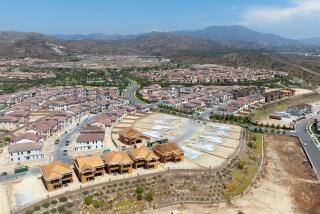O.C. Can Control Its Destiny
Although six of the 10 cities on Forbes’ 2002 list of “The Best Places to Do Business in America” are in California, a May 13 article in The Times bears a more cautious headline, “California Rebound Unclear.” It depicts a business environment characterized by slow employment growth, lessening housing affordability and an uneven recovery from a brief recession.
Orange County, which holds the 10th spot on the Forbes list, displays similar characteristics. Based on the results of UC Irvine’s 2002 Orange County Executive Survey, the financial performance of Orange County firms in 2001 was a mixed bag: 47% of firms reported better performance than they experienced in 2000, but 25% said that 2001 was a comparatively worse year. These numbers are reminiscent of 1992, which was in the depth of the protracted recession experienced in California during the early ‘90s.
Yet when asked about their expectations for 2002, the business executives we spoke to were amazingly upbeat, with 68% anticipating an improved financial position and only 5% forecasting a worse year compared to 2001. Even Orange County’s manufacturing sector, which has been weakening in the last few years, expressed considerable optimism, with 63% of firms anticipating an improved 2002. Such optimism needs to be tempered by the fact that 2001 was a relatively bad year and that very few firms expect 2002 to be a “much better” year.
This cautious optimism is reflected in moderated expansion plans, both in 2002 and over a five-year period. On the upside, plans to downsize in Orange County or to move outside the county are less intense in this year’s survey. As usual, the manufacturing sector leads the pack with respect to downsizing and potential relocation. The expanding sectors are business services, finance, insurance and real estate, and wholesale trade, consistent with the county’s continuing evolution into a primarily service economy.
Employment plans reflect a muted recovery, with 36% of firms expecting to add employees in 2002 (only 1% “substantially more”). While these indicators don’t translate directly into a quantitative forecast of employment growth, they are consistent with an approximate 2% growth rate, or 28,000 jobs, somewhat higher than most other forecasts, which put job growth at 15,000 to 17,000.
Probably the most distressing finding in this year’s survey is the downward trend in Orange County’s attractiveness for business. Only 29% of firms say that the county is becoming a more attractive place to do business, with 17% saying it’s becoming less attractive. Only two years ago, 44% of firms expressed positive feelings about the county’s future, a percentage that had held steady since 1997.
The most substantial drops in optimism about the county have occurred in the finance, insurance and real estate, business services and manufacturing sectors. While Orange County remains attractive because of its location and quality of life, the high cost of housing for employees and growing traffic congestion are the most frequently cited reasons for executives’ negative views.
Of 17 potential barriers to doing business in Orange County, housing costs for employees were cited by 75% of the executives we surveyed as having a moderate or severe impact. The costs of land and building, energy and labor follow in importance.
The housing affordability index for Orange County recently regressed to 29% and continues to worsen. The rental market is tight. Orange County’s plan to force builders to provide 4,000 more homes for low-income families has been criticized for lacking teeth, and without teeth there is no reason to think developers will provide low- and moderate-income housing. The economics of the situation are simply otherwise.
It is important that the cities provide subsidies and incentives for their most critical employees to be able to live near their work. Otherwise we should focus on providing transportation improvements and alternatives to make it more convenient for employees to get to work if they live in such lower-cost areas as San Bernardino and Riverside counties. And we must build more high-density housing in the county so more people can afford to live near their workplace.
The evolution of Orange County into a powerful economic center is simultaneously the good news and the reason we are experiencing problems. High costs are driving manufacturing firms away, and we are now a predominantly service-oriented economy. If we can continue to be a hub of entrepreneurship and innovation, and if government can focus on infrastructure development, education and transportation solutions, the county will prosper.
With city and county governments enjoying high satisfaction ratings at the moment, it remains only for the right decisions to be made.
More to Read
Inside the business of entertainment
The Wide Shot brings you news, analysis and insights on everything from streaming wars to production — and what it all means for the future.
You may occasionally receive promotional content from the Los Angeles Times.










